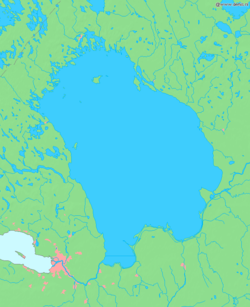Ladoga Lake
| Lake Ladoga | |
|---|---|

Map of Lake Ladoga
|
|
| Location | Northwestern Russia (Leningrad Oblast and the Republic of Karelia) |
| Coordinates | 61°00′N 31°30′E / 61.000°N 31.500°ECoordinates: 61°00′N 31°30′E / 61.000°N 31.500°E |
| Primary inflows | Svir, Volkhov, Vuoksi |
| Primary outflows | Neva |
| Catchment area | 276,000 km2 (107,000 sq mi) |
| Basin countries | Russia, Finland |
| Max. length | 219 km (136 mi) |
| Max. width | 138 km (86 mi) |
| Surface area | 17,700 km2 (6,800 sq mi) |
| Average depth | 51 m (167 ft) |
| Max. depth | 230 m (750 ft) |
| Water volume | 837 km3 (201 cu mi) |
| Surface elevation | 5 m (16 ft) |
| Islands | about 660 (including Valaam) |
| Settlements | see list |
Lake Ladoga (Russian: Ла́дожское о́зеро, tr. Ladozhskoye ozero; IPA: [ˈladəʂskəjə ˈozʲɪrə] or Russian: Ла́дога, tr. Ladoga; IPA: [ˈladəgə]; Finnish: Laatokka [earlier in Finnish Nevajärvi]; Livvi-Karelian: Luadogu; Veps: Ladog, Ladoganjärv) is a freshwater lake located in the Republic of Karelia and Leningrad Oblast in northwestern Russia just outside the outskirts of Saint Petersburg. It is the largest lake entirely in Europe, and the 15th largest freshwater lake by area in the world. Ladoga Lacus, a methane lake on Saturn's moon Titan, is named after the lake.
In one of Nestor's chronicles from the 12th century he mentions a lake called "the Great Nevo", a clear link to the Neva River and, possibly furthermore, to Finnish nevo "sea" or neva "bog, quagmire".
...
Wikipedia
